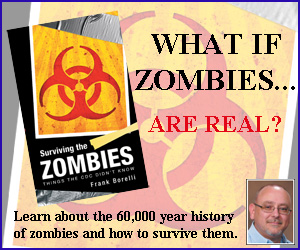Throughout the course of my law enforcement career it has constantly caught my attention how many of my fellow officers – most especially the ones that seem to perform on the street in ways that demand respect – have played contact sports. Given that most of my contemporaries are 45 years of age or older, the popular contact sport of choice in their youth was football. Hockey was also popular, but football – by and large – was the most popular. Sometimes I wondered if their involvement in such a contact sport somehow helped them grow in such a way as to help them be better officers? Maybe I’d have to settle for them just being better people? But the whole wonderment led me to consider the value of playing contact sports in the development of a young man’s – as well as a young woman’s – life.
 So turn your mind back… past conscious comprehension and memory: recognize that, according to people far smarter than I, we all have a basic instinctive response to danger: fight or flight. We can stand and face it or we can run from it. As we grow up, we get injured. We trip even when we’re crawling and faceplant on carpet; concrete; wood flooring; whatever. We cry; our parents pick us up and comfort us. The pain lessens, we heal and life goes on.
So turn your mind back… past conscious comprehension and memory: recognize that, according to people far smarter than I, we all have a basic instinctive response to danger: fight or flight. We can stand and face it or we can run from it. As we grow up, we get injured. We trip even when we’re crawling and faceplant on carpet; concrete; wood flooring; whatever. We cry; our parents pick us up and comfort us. The pain lessens, we heal and life goes on.
How much our parents freak out about those bumps and bruises can have a serious impact on how well we deal with such things later in life. This is discussed more in depth in the article, Teaching People To Be Helpless. For the purpose of this article, what matters is that we learn injuries aren’t permanent. Pain is a signifier of temporary injury that will heal.
Where our Fight or Flight response really gets tested is when we begin interacting with other people – even at a very young age. Preschool, kindergarten… we have disagreements over toys, space, seats, etc. Some children – and we’ve all seen then – are more willing to stand their ground; go “toe to toe” with other kids. Some children will stand but not advance. Other children will turn away – sometimes happily; sometimes in disappointment; sometimes crying. For some of those children – the ones who stand their ground – their first few encounters are severe lessons learned. When they stand their ground and, all of a sudden find themselves on their butt because the other kid DIDN’T stand his ground – but aggressively shoved forward – then they learn that standing and fighting didn’t work so well. Next time they’ll have to decide again: fight or flight.
 Even as older children, if the child decides to stand and fight but ends up on the losing end of the contest, it may affect whether they take a stance in the future, and if so, how. Important to this article are the developmental years – potentially from first interaction with other children to adulthood – wherein the child has the opportunity, parents permitting and supporting, to take part in sports which will force them to confront their fight or flight decision making and (possibly) ultimately help them learn to make more FIGHT decisions than FLIGHT decisions. Here’s what I’m talking about…
Even as older children, if the child decides to stand and fight but ends up on the losing end of the contest, it may affect whether they take a stance in the future, and if so, how. Important to this article are the developmental years – potentially from first interaction with other children to adulthood – wherein the child has the opportunity, parents permitting and supporting, to take part in sports which will force them to confront their fight or flight decision making and (possibly) ultimately help them learn to make more FIGHT decisions than FLIGHT decisions. Here’s what I’m talking about…
Obviously, some sports are contact sports and others aren’t. Remember earlier when I mentioned the number of officers I know who played football in high school? The same was true of the people I knew in the service. Football, as the example, is a sport where you have to:
- KNOW you’re going to get hit, tackled, etc
- KNOW you’re going to have to hit back, make tackles, etc
- KNOW you’re going to have to function before and after every impact unless you’re injured
Using my son as the example, he tried baseball and didn’t really care for it. He spent years in Tae Kwon Do, but even sparring (because of his age), with all the padding he wore, there was little chance he was going to get hurt. He could take the hits and kicks and give as good as he got. No one ever got hurt. He tried football – and met his first challenge. The teams were divided by age instead of size so my son’s first tackling practice (he weighed about 65 pounds at the time) he found himself having to tackle and/or be tackled by kids who outweighed him by as much as 50 pounds. It took about three times for him to be knocked HARD onto his butt before he came to my wife and I and said, “I don’t want to do this anymore. I’ve TRIED but that kid is almost twice my size.”
 I had a mix of emotions. I didn’t want him to quit. On the other hand, after having been knocked over three times – and facing no realistic potential for a change in that pattern – he decided enough was enough. When we asked the sport / coaching staff about the situation re: the kids’ sizes, we were told, “Oh, well. It’s divided by age. The smaller ones don’t get played very much.” Okay…
I had a mix of emotions. I didn’t want him to quit. On the other hand, after having been knocked over three times – and facing no realistic potential for a change in that pattern – he decided enough was enough. When we asked the sport / coaching staff about the situation re: the kids’ sizes, we were told, “Oh, well. It’s divided by age. The smaller ones don’t get played very much.” Okay…
I still had this concern in my head as to whether or not my son would really stand his ground when things got ugly. Did he know that pain was just an indicator of some injury? Would he be able to gauge pain versus functionality and learn to perform in spite of bumps and bruises? Then along came lacrosse. My son asked to play. It’s not a sport I knew anything about, but that’s cool. We found a local team and got the necessary equipment. He was enthusiastic.
Two games into the season he was proudly showing off the bumps, bruises, cuts and scrapes from practice and games. He went toe to toe with other players, gave and received, within the rules, and shaken off whatever discomfort was incurred to keep performing in the game. There is value in that – for everyone, but especially for anyone who grows up and goes into a profession that REQUIRES performance in the face of confrontation.
Think about it: how would our streets be if every officer backed away from every confrontation? If we exercised the FLIGHT option instead of the FIGHT option? Now, don’t get me wrong. I don’t know many officers who ENJOY fighting (yes, there are a few), but virtually every officer I know understands that they have to stand their ground as duty demands and circumstances permit. Sure, there are times when backing up is the best option but when duty demands, we can’t run away. We have to stand and face whatever is coming our way.
 The intestinal fortitude to do that – to face danger or discomfort and NOT back down is something that can be learned – to some extent – in the playing of contact sports. The “Fight” part is learned within the relative safety of structure, rules and equipment. But the character lessons that are learned are rarely, if ever, forgotten.
The intestinal fortitude to do that – to face danger or discomfort and NOT back down is something that can be learned – to some extent – in the playing of contact sports. The “Fight” part is learned within the relative safety of structure, rules and equipment. But the character lessons that are learned are rarely, if ever, forgotten.
Sadly, as much as these sports are still popular, a whole host of other sports have sprung up that don’t involve teamwork or direct confrontation. Typically these new sports involve a single person performing specific tasks under given circumstances, competing against other individuals performing the same way. Many of these sports are very dangerous – but facing the fear isn’t the same as facing direct confrontation. A person can learn to control their fear of circumstance – especially if it’s under conditions they create and willingly enter – but in doing so they don’t reinforce their personal response to a conflict situation. Fight or Flight?
In a society where we are experiencing a shortage of men and women who are willing to volunteer to put on a military uniform, and a reduction in the number of qualified applicants for law enforcement jobs, I can’t help but wonder if it would do us some good to focus more on contact sports for our children than for extreme bicycling or skate-boarding? It’s just a thought.
